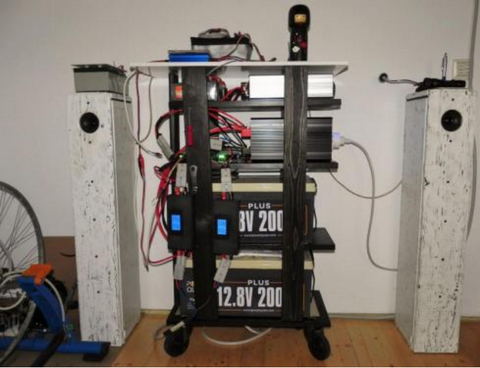


At the beginning, the system was just an experiment to see what it would take to supply a small residential house independently of the public grid.
The house is located in the south-east of Austria. According to statistics, the sun shines 300 days a year.
Exterior view of the PV panel installation. This is not yet the final version. The area of the PV panels is sufficient for the period from April to November. For the winter months, the area must be enlarged.
General view of the technology. All components are installed in a rack with wheels specially designed rack with wheels. The two LiFePO4 batteries can be seen below. The two black boxes with the blue displays are displays are measuring devices for current, voltage, power and energy for each one of two PV panel groups.
Immediately above them are two solar controllers (not clearly visible in the
photos). The large black box next to it on the right on the third floor is an
inverter. It turns the battery voltage into a pure 50Hz/220V mains voltage.
A second, smaller inverter is located on the next floor above. It is
not in operation and only serves as a backup in case of a failure.
At the bottom left of the picture you can see the rear wheel of an old racing bike. I have
connected it to an e-bike motor as a generator so that it can be used as a home trainer.
as a home trainer. One hour of cycling charges - depending on motivation ;-) - 60
to 100Wh into the battery. This is approximately the energy needed to boil water for two large cups of tea. You learn to appreciate how precious electrical energy is :-)
The rack again from the front-right. At the output of the inverter a power monitor is plugged in to see what the relation of input power to output power.
Close-up of the two beautiful batteries and the measuring devices for the PV panel outputs. The cable cross-sections are thin but completely sufficient because the voltage upstream of the charge controllers is much higher than the battery voltage while the currents are correspondingly lower.
Kind regards from sunny Burgenland
Robin
Tags
Blog posts
-

, by Kookie Zhang Will RV Fridge Run Off Battery While Driving?
-

, by Kookie Zhang Group 24 VS Group 27 Battery: What’s the Difference?
-

, by Kookie Zhang [Full Guide] What Is A Group GC2 Battery
Featured products
Share information and details about these products
























































































































![[5% OFF Only $402] Power Queen 12V 200Ah PLUS Deep Cycle Lithium Battery Power Queen](http://ipowerqueen.com/cdn/shop/files/5_-OFF-Only-_402_-Power-Queen-12V-200Ah-PLUS-Deep-Cycle-Lithium-Battery-Power-Queen-40707029.jpg?v=1729852516&width=645)

![[5% OFF Only $417] Power Queen 24V 100Ah Deep Cycle Lithium Battery Power Queen](http://ipowerqueen.com/cdn/shop/files/5_-OFF-Only-_417_-Power-Queen-24V-100Ah-Deep-Cycle-Lithium-Battery-Power-Queen-40707166.jpg?v=1729852572&width=645)



![[5% OFF Only $503] Power Queen 12V 280Ah Low-Temp Deep Cycle Lithium Battery Power Queen](http://ipowerqueen.com/cdn/shop/files/5_-OFF-Only-_503_-Power-Queen-12V-280Ah-Low-Temp-Deep-Cycle-Lithium-Battery-Power-Queen-40707227.jpg?v=1729852615&width=645)

![[5% OFF Only $541] Power Queen 12V 300Ah Deep Cycle Lithium Battery Power Queen](http://ipowerqueen.com/cdn/shop/files/Power-Queen-12V-300Ah-Deep-Cycle-Lithium-Battery.jpg?v=1736387315&width=645)

![[6% OFF Only $1033] Power Queen 12V 410Ah Deep Cycle Lithium Battery Power Queen](http://ipowerqueen.com/cdn/shop/files/6_-OFF-Only-_1033_-Power-Queen-12V-410Ah-Deep-Cycle-Lithium-Battery-Power-Queen-40707481.jpg?v=1729852675&width=645)





![Copy of [Only $239.99] Power Queen 12.8V 100Ah Low-Temp LiFePO4 Battery Perfect for Trolling Motor, Built-in 100A BMS, Match BCI Group 31 Battery Box Power Queen](http://ipowerqueen.com/cdn/shop/files/Copy-of-_Only-_239.99_-Power-Queen-12.8V-100Ah-Low-Temp-LiFePO4-Battery-Perfect-for-Trolling-Motor_-Built-in-100A-BMS_-Match-BCI-Group-31-Battery-Box-Power-Queen-35552893.jpg?v=1706845679&width=645)
![[Like New] Power Queen 12V 100Ah Low-Temp Deep Cycle Lithium Battery](http://ipowerqueen.com/cdn/shop/files/1_2fe8ffcf-bb0e-4682-90ad-c954bd4a0a6f.jpg?v=1734945468&width=645)
![[Only $799] Power Queen 36V 100Ah Smart Deep Cycle Lithium Battery Power Queen](http://ipowerqueen.com/cdn/shop/files/Only-_799_-Power-Queen-36V-100Ah-Smart-Deep-Cycle-Lithium-Battery-Power-Queen-40707943.jpg?v=1729852834&width=645)






